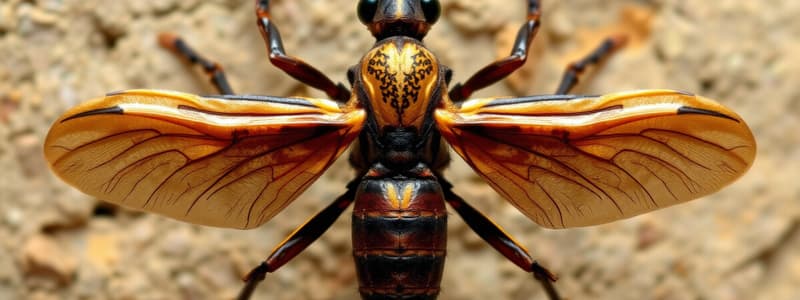Podcast
Questions and Answers
What are the first distant ancestors of insects mentioned?
What are the first distant ancestors of insects mentioned?
Trilobites and horseshoe crabs
When did the first insect fossils appear?
When did the first insect fossils appear?
380 million years ago
Which of the following insects was first cataloged by Theophrastus as a crop pest?
Which of the following insects was first cataloged by Theophrastus as a crop pest?
- Grasshoppers (correct)
- Beetles (correct)
- Bees (correct)
- Butterflies (correct)
Pliny the Elder cataloged more insect species than Aristotle.
Pliny the Elder cataloged more insect species than Aristotle.
Johann Sperling discussed at least ______ species of beetles.
Johann Sperling discussed at least ______ species of beetles.
Who is known as the Father of Zoology?
Who is known as the Father of Zoology?
What was the main contribution of Carl von Linne?
What was the main contribution of Carl von Linne?
How many species of butterflies did John Ray estimate existed in England?
How many species of butterflies did John Ray estimate existed in England?
Flashcards are hidden until you start studying
Study Notes
Fossils and Amber
- Insects and their relatives predate dinosaurs, showcasing a rich evolutionary history.
- Trilobites existed between 400-600 million years ago; horseshoe crabs appeared around 350 million years ago.
- The earliest insect fossils, small and wingless, date back to approximately 380 million years ago; relatives resembling modern dragonflies emerged between 250-280 million years ago.
- Many modern insect relatives were present before the Jurassic period, around 180 million years ago.
- Mid Tertiary period saw the emergence of many contemporary insect species, around 25-30 million years ago.
Tracing the Literature
- Ancient records include cave drawings from 6,000 BC, early references to silkworms in China (~4,700 BC), honeybees and scarabs in Egypt (~3,500 BC), and body pests in Greece (~1,000 BC).
- Aristotle (384-322 BC), the Father of Zoology, authored "Historia Animalium," laying foundational observations of animals, including insects.
- Theophrastus (380-287 BC) is recognized for being the first to catalog crop pests related to insects.
- Pliny the Elder (23-79 AD) contributed extensively in "Historia Naturales," particularly in Book 11, highlighting early entomological knowledge.
- Documented species were limited, with Aristotle recognizing 47 insect species and Pliny identifying 61, including grasshoppers, beetles, bees, butterflies, flies, and aphids.
Contributions of Naturalists
- Johann Sperling (1661) documented over 40 beetle, 50 caterpillar, 70 fly, and over 100 butterfly species, emphasizing the diversity of insects.
- John Ray (1627-1705) estimated at least 150 species of butterflies and beetles in England, hypothesizing a total of around 10,000 species globally in terrestrial and aquatic environments.
Carl von Linne (Linnaeus)
- Introduced binomial nomenclature in the 10th edition of "Systema Naturae" (1758), standardizing the scientific naming of organisms and providing a systematic framework for classifying insects.
Studying That Suits You
Use AI to generate personalized quizzes and flashcards to suit your learning preferences.




